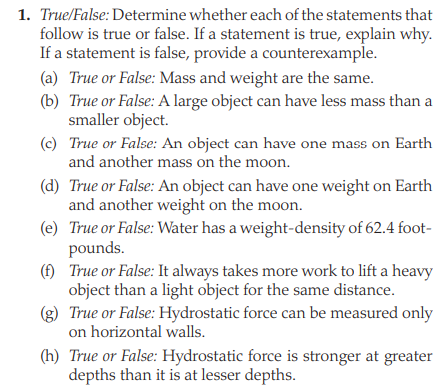1. True/False: Determine whether each of the statements that follow is true or false. If a statement is true, explain why. If a statement is false, provide a counterexample. (a) True or False: Mass and weight are the same. (b) True or False: A large object can have less mass than a smaller object. (c) True or False: An object can have one mass on Earth and another mass on the moon. (d) True or False: An object can have one weight on Earth and another weight on the moon. (e) True or False: Water has a weight-density of 62.4 foot- pounds. (f) True or False: It always takes more work to lift a heavy object than a light object for the same distance. (g) True or False: Hydrostatic force can be measured only on horizontal walls. (h) True or False: Hydrostatic force is stronger at greater depths than it is at lesser depths.
1. True/False: Determine whether each of the statements that follow is true or false. If a statement is true, explain why. If a statement is false, provide a counterexample. (a) True or False: Mass and weight are the same. (b) True or False: A large object can have less mass than a smaller object. (c) True or False: An object can have one mass on Earth and another mass on the moon. (d) True or False: An object can have one weight on Earth and another weight on the moon. (e) True or False: Water has a weight-density of 62.4 foot- pounds. (f) True or False: It always takes more work to lift a heavy object than a light object for the same distance. (g) True or False: Hydrostatic force can be measured only on horizontal walls. (h) True or False: Hydrostatic force is stronger at greater depths than it is at lesser depths.
College Physics
1st Edition
ISBN:9781938168000
Author:Paul Peter Urone, Roger Hinrichs
Publisher:Paul Peter Urone, Roger Hinrichs
Chapter4: Dynamics: Force And Newton's Laws Of Motion
Section: Chapter Questions
Problem 4PE: Since astronauts in orbit are apparently weightless, a clever method of measuring their masses is...
Related questions
Question

Transcribed Image Text:1. True/False: Determine whether each of the statements that
follow is true or false. If a statement is true, explain why.
If a statement is false, provide a counterexample.
(a) True or False: Mass and weight are the same.
(b) True or False: A large object can have less mass than a
smaller object.
(c) True or False: An object can have one mass on Earth
and another mass on the moon.
(d) True or False: An object can have one weight on Earth
and another weight on the moon.
(e) True or False: Water has a weight-density of 62.4 foot-
pounds.
(f) True or False: It always takes more work to lift a heavy
object than a light object for the same distance.
(g) True or False: Hydrostatic force can be measured only
on horizontal walls.
(h) True or False: Hydrostatic force is stronger at greater
depths than it is at lesser depths.
Expert Solution
This question has been solved!
Explore an expertly crafted, step-by-step solution for a thorough understanding of key concepts.
This is a popular solution!
Trending now
This is a popular solution!
Step by step
Solved in 8 steps

Recommended textbooks for you

College Physics
Physics
ISBN:
9781938168000
Author:
Paul Peter Urone, Roger Hinrichs
Publisher:
OpenStax College


An Introduction to Physical Science
Physics
ISBN:
9781305079137
Author:
James Shipman, Jerry D. Wilson, Charles A. Higgins, Omar Torres
Publisher:
Cengage Learning

College Physics
Physics
ISBN:
9781938168000
Author:
Paul Peter Urone, Roger Hinrichs
Publisher:
OpenStax College


An Introduction to Physical Science
Physics
ISBN:
9781305079137
Author:
James Shipman, Jerry D. Wilson, Charles A. Higgins, Omar Torres
Publisher:
Cengage Learning

College Physics
Physics
ISBN:
9781285737027
Author:
Raymond A. Serway, Chris Vuille
Publisher:
Cengage Learning

College Physics
Physics
ISBN:
9781305952300
Author:
Raymond A. Serway, Chris Vuille
Publisher:
Cengage Learning